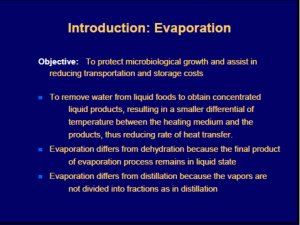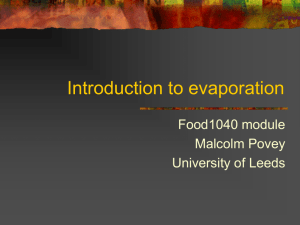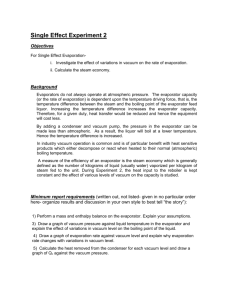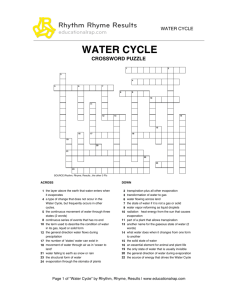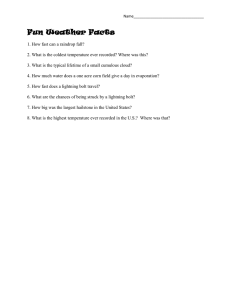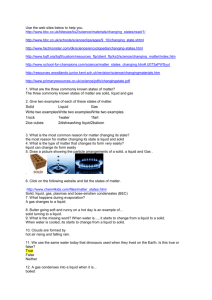Gen. Math. Notes, Vol. 1, No. 2, December 2010, pp.... ISSN 2219-7184; Copyright © ICSRS Publication, 2010
advertisement
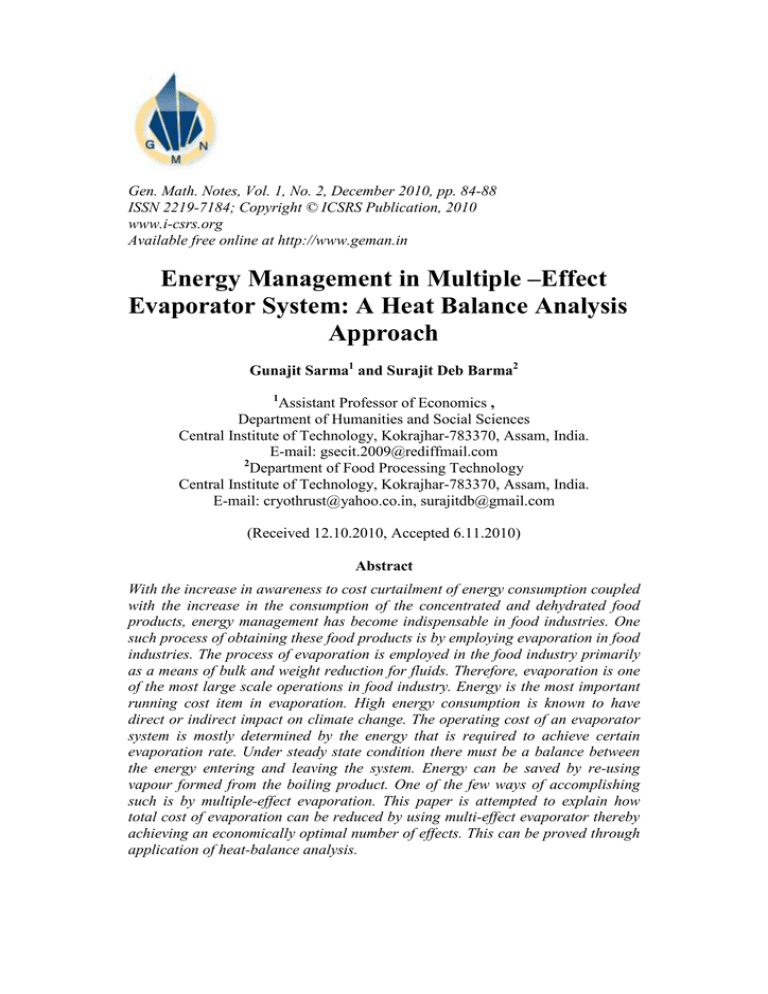
Gen. Math. Notes, Vol. 1, No. 2, December 2010, pp. 84-88 ISSN 2219-7184; Copyright © ICSRS Publication, 2010 www.i-csrs.org Available free online at http://www.geman.in Energy Management in Multiple –Effect Evaporator System: A Heat Balance Analysis Approach Gunajit Sarma1 and Surajit Deb Barma2 1 Assistant Professor of Economics , Department of Humanities and Social Sciences Central Institute of Technology, Kokrajhar-783370, Assam, India. E-mail: gsecit.2009@rediffmail.com 2 Department of Food Processing Technology Central Institute of Technology, Kokrajhar-783370, Assam, India. E-mail: cryothrust@yahoo.co.in, surajitdb@gmail.com (Received 12.10.2010, Accepted 6.11.2010) Abstract With the increase in awareness to cost curtailment of energy consumption coupled with the increase in the consumption of the concentrated and dehydrated food products, energy management has become indispensable in food industries. One such process of obtaining these food products is by employing evaporation in food industries. The process of evaporation is employed in the food industry primarily as a means of bulk and weight reduction for fluids. Therefore, evaporation is one of the most large scale operations in food industry. Energy is the most important running cost item in evaporation. High energy consumption is known to have direct or indirect impact on climate change. The operating cost of an evaporator system is mostly determined by the energy that is required to achieve certain evaporation rate. Under steady state condition there must be a balance between the energy entering and leaving the system. Energy can be saved by re-using vapour formed from the boiling product. One of the few ways of accomplishing such is by multiple-effect evaporation. This paper is attempted to explain how total cost of evaporation can be reduced by using multi-effect evaporator thereby achieving an economically optimal number of effects. This can be proved through application of heat-balance analysis. 85 Energy management in multiple- effect evaporator system Keywords: evaporation, energy, multiple-effect evaporator 1 Introduction With the increase in awareness to cost curtailment of energy consumption coupled with the increase in the consumption of the concentrated and dehydrated food products, energy management has become indispensable in food industries. Energy is the most important running cost item in evaporation. The operating cost of an evaporator system is mostly determined by the energy that is required to achieve certain evaporation rate [1]. Evaporation involves the application of heat to vaporize water at the boiling point [2]. Under steady state condition there must be a balance between the energy entering and leaving the system [1]. The number of effects is equal to the number of evaporators used. In multiple-effect evaporator, steam is used only in the first effect [3]. The first stage acts as a steam generator for the second which acts as a condenser to the first and so on [4]. Multiple-effect evaporator is useful when desired concentration of a product obtained after evaporation is not achieved and requires further evaporation. The product from first effect is introduced as feed in the second evaporator and so on till desired concentration of a product is achieved. The preceding characteristics of liquid food are an important perspective while designing evaporation systems [3]. The present study will show how cost saving can be carried out using heat balance analysis. The study needs to be verified further using both experimental and numerical methods. 2 Underlying Principle For heat transfer occurrence, a temperature drop is necessary in each effect. This implies that the temperature of the vapour generated in a given effect must be greater than the boiling temperature in the succeeding effects, that is, T1 > T2 >…>Tn. Therefore, the total temperature difference is that between the maximum heating temperature in effect 1 and the lowest boiling temperature in the last effect. This is distributed between the individual effects and therefore the larger the number of effects, the smaller the temperature difference for each effect. This in turn increases the heating surface required to achieve a given evaporation rate. For consumer needs we consider all these and many other relevant parameters to optimize each plant to meet the client's specific requirements. With the cost analysis, consumers are supported to meet their budgets and the plant performance .Therefore the application of multiple-effect evaporation is beneficial for cost consideration as well as energy consumption. 2.1 Heat Balance Analysis Gunujit Sarma and Surajit Deb Barma 86 Fig. 1 Triple-Effect Evaporation Plant Layout Source: GEA, 2010 Heat balance for the first effect (Fig.1) is given by: Q1 = U1 A1 (Ts - T1) = U1A1 ∆T1 (1) where Q1 is the rate of heat transfer, U1 is the overall heat transfer coefficient in first effect, A1 is the heat-transfer area in first effect, Ts is the temperature of condensing steam from the boiler, T1 is the boiling temperature of the liquid in first effect and ∆T1 is the temperature difference in first effect, = (Ts - T1). Similarly, For second effect and third effect, we have Q2 = U2 A2 (T1 - T2) = U2A2 ∆T2 (2) Q3 = U3 A3 (T2 – T3) = U3A3 ∆T3 (3) in which the subscripts 2 and 3 indicate the parameters (similar to first effect) in the second effect and third effect respectively If heat losses are neglected and A1=A2=A3, then Q1 = Q2 = Q3, i.e., U1A1 ∆T1 = U2A2 ∆T2 = U3A3 ∆T3 or U1∆T1 = U2∆T2 = U3∆T3 or U1 / U2 = ∆T2 / ∆T1 or U2 / U3 = ∆T3 / ∆T2 (4) We see that that the temperature differences are inversely proportional to the overall heat transfer coefficients in the three effects. 87 Energy management in multiple- effect evaporator system Considering that A1 = A2 = A3 and U1 = U2 = U3= Us, where Us is the overall heat transfer coefficient for single effect evaporator, let us find the equivalent heat exchange area As of a single effect that will evaporate the same quantity of steam as that of three effects. Now, ∆T1 = ∆T2 = ∆T3 i.e., ∆Ts = ∆T1 + ∆T2 + ∆T3 = 3 ∆T1 or ∆T1 = 0.33 ∆Ts Also, Q1 + Q2 + Q3 = U1A1 ∆T1 + U2A2 ∆T2 + U3A3 ∆T3 = U1 (A1 + A2 + A3) ∆Ts/3 or Q1 + Q2 + Q3 = U1 A1 ∆Ts = Us As ∆Ts = Qs (considering the same conditions of single effect evaporator as that of first effect evaporator) Therefore, (A1 + A2 + A3)/3= 3 A1/3 = As (5) The above equation shows that the evaporation capacity of each of the three effects should be the same as that of a single effect evaporator system with the condition that they have the same total temperature drop. This analysis can be extended to any number of effects under the same conditions. Table 1 Steam consumption and running cost of evaporators Number of effects Steam Consumption (kg Total running cost steam/kg water (relative to a single evaporated) effect evaporator) One 1.1 1 Two 0.57 0.52 Three 0.40 0.37 Source: R. L. Earle, 1983 In Table 1 [5], steam consumption decreases with the increase in number of effects. So is the total running cost. However the minimum total cost of evaporation will be at the economically optimal number of effects as shown in fig.2. Gunujit Sarma and Surajit Deb Barma 88 Fig.2 Economically optimal number of effects Source: Berk, 2009 3 Conclusions The quantity of steam consumed is inversely proportional to the number of effects. The capital cost (fixed cost) of a multiple-effect evaporator is approximately proportional to the number of effects. The running cost (variable cost) of a multiple-effect evaporator is almost inversely proportional to the number of effects. For exact design purposes more realistic assumptions meeting specific requirements are to be made. Trial-and-error techniques are followed for calculation purposes so as to arrive at final pre-designed parameters. References [1] GEA Process Engineering Inc. Columbia, (2010). http://www.niroinc.com/evaporators_crystallizers/energy_evaporation_plants.asp (accessed 20 September 2010) [2] R.T. Toledo, Fundamentals of Food Process Engineering,CBS Publishers & Distributors, New Delhi, (1997). [3] R.P. Singh and D.R. Heldman, Introduction to Food Engineering, Academic Press, Elsevier, (2009). [4] Z. Berk, Food Process Engineering and Technology, Academic Press, Elsevier , (2009). [5] R. L. Earle, Unit Operations in Food Processing, The New Zealand Institute of Food Science and Technology Inc, New Zealand, (1983). http://www.nzifst.org.nz/unitoperations/evaporation2.htm (accessed 20 September 2010)
